Anderson – A Charming Little City – “Anderson, S.C. is one of the healthiest places in Upper Carolina. While the city has been steadily advancing, her growth so far has not been remarkable, but Anderson is now on the verge of a genuine and well-deserved boom. For some reason her people have been too modest to press the claims of their municipality and have neglected to post the outside world as to the great advantages—social, industrial, and hygenic—which Anderson possesses and which she offers to visitors and settlers.
For years Anderson has been held down almost to stagnation on account of her inability to communicate with the outside world, except by way of a railroad operated by an unprogressive and unsympathetic corporation. But now all this is changed, and the millstone has been taken from her neck by the completion of the Savannah Valley
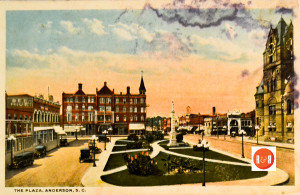
Postcard image courtesy of the Revels Collection – 2015
Railroad. Her railroad facilities have been trebled, her shackles are removed, and the city and county of Anderson are infused with new life and hope, and she can now take her place among the booming towns of South Carolina.
The present city administration is broad and progressive. The officers are: Mayor, G.F. Tolley; aldermen, T.F. Hill, J.L. McGee, J.G. Cunningham, Foster Fant, J.M. Payne, and C.F. Jones; clerk of council, J.D. Maxwell. Chief R.F. McKinney and three policemen keep the city in perfect order. The hook and ladder company is a crack organization of young white men, who have been first prize winners at Charlotte and elsewhere.
The Anderson Board of Trade, organized fourteen years ago, was reorganized last March under new regulations by the election of the following officers: President, J.M. Sullivan; vice president, J.D.
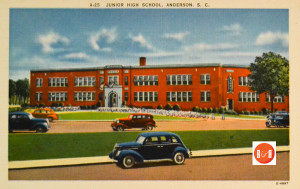
Postcard image courtesy of the Revels Collection – 2015
Maxwell; secretary and treasurer, R.S. Ligon; executive committee, S.M. Orr, J.E. Peoples, C.F. Jones, R.S. Hill, and J.J. Fretwell. There are two other standing committees, one on manufacture, in charge of the manufacturing interests of the city, and one on transportation and freight rates. Over sixty business firms are represented on the board to whose untiring efforts the completion of the Savannah Valley Railroad and the recent organization of the Anderson Cotton Mill are mainly due.
The Anderson Intelligencer contained an ad on May 1, 1884 – “From John E. Peoples stating I have just opened a superb line of French china available in sets or by the single piece. I also carry silver plated ware, baskets and other goods.”
A delegation from the board lately attended the Immigration Convention at Hot Springs. A committee, with Major E.B. Murray chairman, are now engaged in the preparation of an Anderson County exhibit for the Augusta National Exposition. The board is always at the front in any enterprise or movement for the material advancement of Anderson. The present day tax in Anderson is three mills, the dty
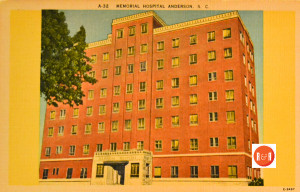
Postcard image courtesy of the Revels Collection – 2015
having been cut off from the handsome revenue previously derived from liquor licenses. The city will, however, be profitably wet after January 1, 1889. Postmaster C.W. Webb occupies the handsomest post office in the up-country, a new brick building rented by the Government from Mr. J.H. Von Hasseln. The receipts of the office last year were $3,600 and are increasing every month. The money-order business has grown rapidly since the completion of the Savannah Valley Railroad, and the business of the office will require additional derical force before the coming winter. Five mails are dispatched and five received daily. There are also five Star routes supplying twenty-two offices. Postmaster Webb and his courteous assistant give the Anderson public first-class service, and the office is a model one in every respect.
The Rock Hill Herald reported on May 26, 1881 – “The Piedmont Factory is flourishing and has a capital stock of $500,000. The Pres. and Treasurer is Col. H.P. Hammett. The mill supports a flourishing school and pays for the minister for the Village Church. The mill is now engaged in filling an order for 1,200 bales of sheeting to be exported to China.”
The Anderson Building and Loan Association was organized in June 1883. President, P.K. McCully; secretary and treasurer, J.D. Maxwell; directors, W.H. Nardin, WW. Humphreys, G.F. Tolley, D.S. Maxwell, D.S. Taylor, M.P. Tribble, A.B. Towers, and S.M. Orr. Capital stock paid in $61,000, assets $100,000. This association has done more to build up Anderson than any other agency, furnishing money to poor people who could never otherwise have raised the means to build. And the Anderson Bank, organized in January 1873, owns the handsome brick building it occupies. President, Jos. N. Brown; cashier, J. A. 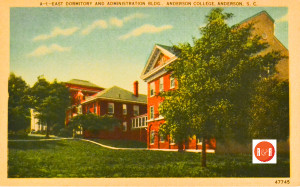
Postcard image courtesy of the Revels Collection – 2015Brock; teller, B. Frank Mauldin. Capital $50,000, surplus $135,000, deposits $150,000, loans $280,000. The bank is furnished with a $7,000 fire and burglar proof vault, time locks, and all modem safeguards…
On May 27, 1891 – “Mr. Alexander, a contractor from Anderson is in Due West to make a bid on the new building at Erskine College.”
The Anderson Cotton Mill Company, recently organized, has already raised $100,000 towards the erection of a $300,000 factory. One-half of this amount has been promised by Northern capitalists and ground will be broken within a few days. The president of the new company is Mr. J. A. Brock; secretary, J.J. Baker; directors, J.N. Brown, S. Bleckley, Geo. A. Wagener, A.J. Sitton, WW. Humphreys, W.G. Watson, A.A. Dean, and S.M. Orr.
The Anderson Oil and Fertilizer Company has been running for three years under the successful management of Superintendent G.H. Townsend, President J.A. Brock, and Treasurer B. Frank Mauldin. The capacity of the mill is 50,000 bushels of cotton seed annually. Another Anderson enterprise is the new machine shop and boiler factory of Dr. R.F. Diwer, a machinist of thirty years’ experience. This establishment has been provided with the newest and most approved appliances, planers, drills, forges, &c., for the manufacture and repair of boilers, engines, gins, and machinery of all kinds. Dr. Diwer has just signed a contract for the manufacture of the Taylor gin-saw filing machine.
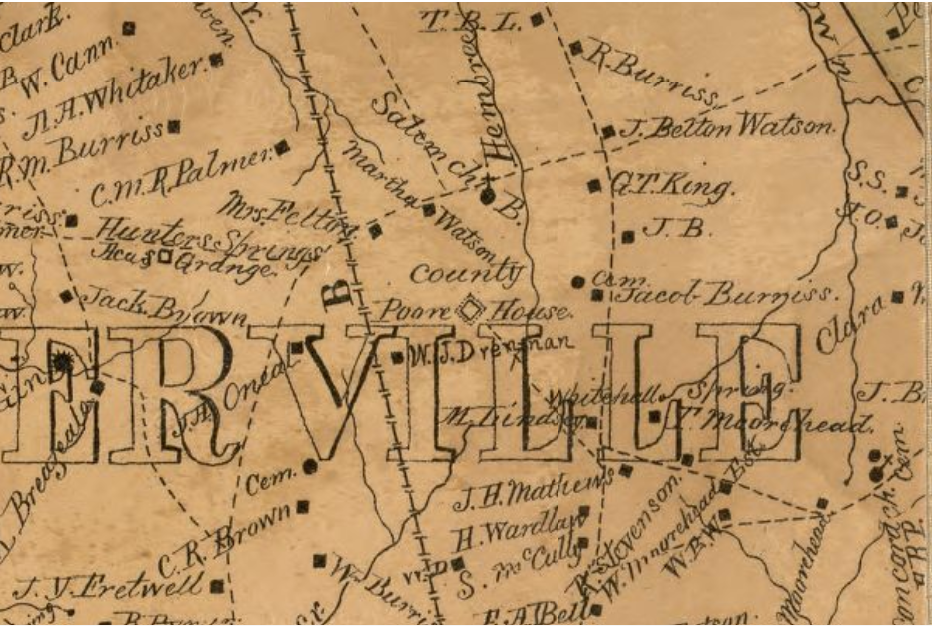
Township Map of Anderson Co., S.C. showing the Poor House – 1877
The Sullivan Hardware Company have a factory for the manufacture of combination wire and picket fencing, which they ship all over the State. Messrs. Barton & Townsend run successfully a large planning and turning mill. R.A. Mayfield owns a large planning and grist mill. Mr. James Barton is about to build an extensive wagon factory, employing a number of hands. The population of Anderson was 1,900 in 1880, 3,000 in 1885, and has increased steadily since.
The cotton shipments, notwithstanding the thousands of bales diverted to the Pelzer and Piedmont mills on the outskirts of the county, are 20,000 bales per annum. The merchants of the town do an annual business of one and one-quarter million dollars. Anderson claims to be the best stock market in the State above Columbia, the horse and mule sales of one firm alone amounting to $100,000 in six months.
Mr. G.F. Tolley has one of the largest wholesale and retail furniture establishments in the State, shipping furniture to points within a few miles of Atlanta and excelling that city in prices and enterprise. The merchants of Anderson are liberal and progressive. Among them are the following firms: Bleckley, Brown & Fretwell, general merchandise; McCully, Cathcart & Co., general merchandise; Crayton, Jones & Seybt, dry goods merchandise; C.F. Jones, dry goods; R.S. Ligon, groceries; Brownlee & Brown, fancy groceries; J.N. Watkins, book store; A.B. Towers, general merchandise; Wilhite & Wilhite, druggists; R.S. Hill, general merchandise; W.A. Chapman, dry goods; W.R Barr, general merchandise; J.R Sullivan & Co., general merchandise; Dennis O’Donnell, groceries; Moss & Brown, groceries; D.S. Taylor, general merchandise; Cunningham Bros., general merchandise; A.R Hubbard, general merchandise; Lewis Sharp, confectionery; J.A. Daniels, jeweler; G.M. Tolley, confectionery; Hill Bros., druggists; C. A. Reed, sewing machines and buggies, also music house; F.M. Butler, cigars; Simpson & Co., drugs; H. Webb, groceries; N.O. Farmer & Bro., general merchandise; L.H. Seel, stoves, tin, and hardware; J.M. Hubbard & Bro., jewelers and silverware; G.W. Fant & Son, books and stationery; Foster Fant, clothing; Clark & Bros., merchant tailors; J.S. Fowler, livery and sale stable; John Cattlet, livery, &c.; J.E. Peoples, livery and sale stable; E.W. Taylor & Co., groceries; Miss Sallie Bowie, millinery and dry goods; S.T. Craig, bakery; J.D. Maxwell, photography gallery; J.E. Peoples, stoves and tinware; A. Lesser, dry goods; Watson & Son, general merchandise; Miss Lizzie Williams, millinery and dry goods; Orr & Sloan, drugs; J.J. Baker & Co., general merchandise; John O’Donnell, groceries; F.P. Mimnaugh, dry goods, hats, &c.; and B.F. Crayton & Sons, groceries and provisions.
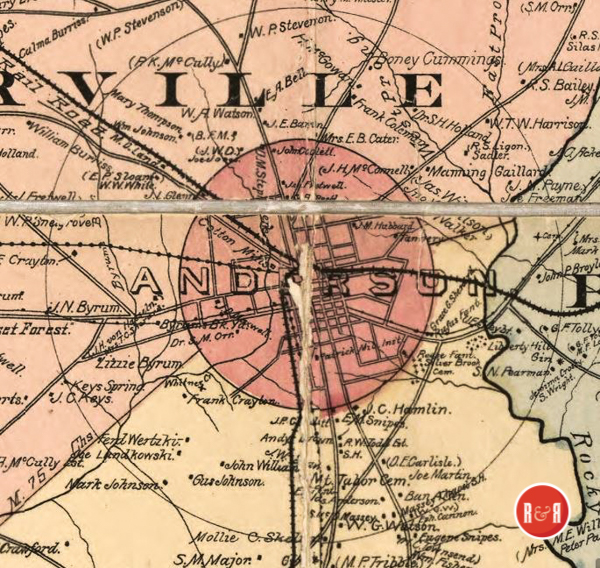
Von Hasseln, J. H, and George B Brown. Map of Anderson County, South Carolina. Anderson, S.C.: J.H. von Hasseln, 1897. Map. Retrieved from the Library of Congress
The Patrick Military Institute was opened last September by Capt. J.B. Patrick, who for years conducted a military school in Greenville. One hundred and twelve boys are enrolled. The full high school course is exacted and the boys are drilled every day. Capt. Patrick has the able assistance of Prof. W.J. Ligon and John M. Patrick. The cadets are divided into two companies, one commanded by Capt. J.H. Coker of Darlington and the other by Capt. J.D. Lowrance of Columbia. There are three flourishing primary schools in Anderson conducted respectively by Miss L.C. Hubbard, Miss Maggie Evans, and Mrs. J. Scott Murray.
The Methodists have just completed a large and handsome $12,000 church designed by Mr. A.W. Todd, an Anderson architect of much promise. The membership is about 250, and the pastor is the Rev. W.S. Wightman. The Baptist congregation, a very large one, is in charge of the Rev. A. A. Marshall, recently called from Gainesville, Ga. They are about to make a $6,000 improvement to the already fine church building. The Rev. D.E. Frierson, D.D., is the pastor of the Presbyterian Church, which is a handsome building occupied by a large congregation. The Rev. T.F. Gadsden is the rector of Grace Episcopal Church, a pretty little structure.
Anderson is well supplied with newspapers. The Intelligencer and the Journal are both live and progressive journals, wide-awake to the best interests of the community and Democratic to the core. They carefully reflect the best sentiment of the community on all public questions and have a large number of readers.”
Reprinted from South Carolina in the 1880s: A Gazetteer by J.H. Moore, Sandlapper Publishing Company – 1989
Stay Connected
Explore history, houses, and stories across S.C. Your membership provides you with updates on regional topics, information on historic research, preservation, and monthly feature articles. But remember R&R wants to hear from you and assist in preserving your own family genealogy and memorabilia.
Visit the Southern Queries – Forum to receive assistance in answering questions, discuss genealogy, and enjoy exploring preservation topics with other members. Also listed are several history and genealogical researchers for hire.
User comments welcome — post at the bottom of this page.
Please enjoy this structure and all those listed in Roots and Recall. But remember each is private property. So view them from a distance or from a public area such as the sidewalk or public road.
Do you have information to share and preserve? Family, school, church, or other older photos and stories are welcome. Send them digitally through the “Share Your Story” link, so they too might be posted on Roots and Recall.
Thanks!

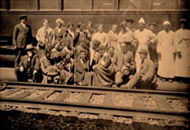
My name is Wendy Diaz. My husband, Dario Diaz, and I have lived at 407 Spring Park Dr. Anderson S. C. since May of 1990. I remember the attorney at closing said something about an architect had built our home. We were young, newly married, and new to Anderson at the time, so we were not familiar with the history of Anderson. After commuting back and forth to Greenville for over 20 years, we regretfully had to make the tough decision to move back to Greenville. Over the years, we were told that a Mr. and Mrs. Hall were the original owners and the property that had been purchased by a J. Dexter Brown and given to a Nellie C. (Brown) Hall on March 15, 1946. We were told by an older neighbor that the Halls were not able to have kids so they had built the house with only two bedrooms and the rest of the house and large circle driveway was built for entertaining, because Mrs. Hall was a part of the garden club, and Mr J.B. Hall worked and was a nephew of the owner of the Anderson Independent newspaper. We have been doing some more investigating, and that is how we found a few of your articles, but we would love to connect the dots and be certain if our home was built by the North Anderson Development Company. I have tried to find out more info over the years, but would love to pass on accurate information to whomever buys the house.
Thanks in advance,
Dario & Wendy Diaz